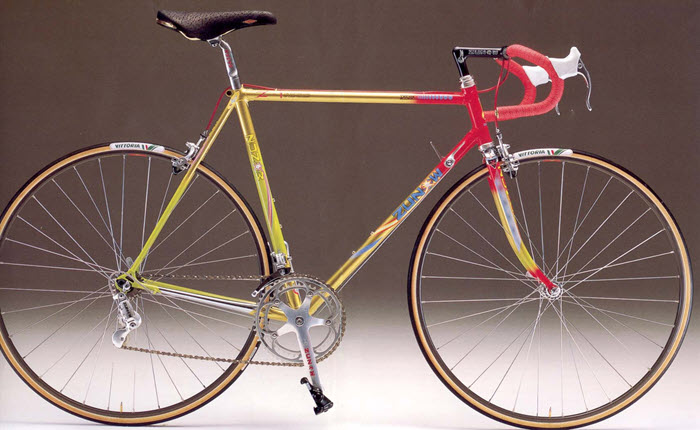
In this article we will focus mainly on the “Bike Boom” of 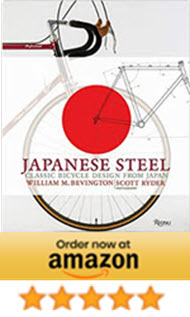 the 70’s and the men who brought the Japanese bikes to America. During this time their determination and fortitude created some of the highest quality bicycles from Japan.
the 70’s and the men who brought the Japanese bikes to America. During this time their determination and fortitude created some of the highest quality bicycles from Japan.
Most of the early brands were being manufactured in Europe. But the manufacturers were not keeping up with demand here in the States. The bikes were becoming more expensive to import and the quality was starting to decline.
IMPORTERS LOOKING FOR BETTER PRICING
In order to keep business costs effective, the importers were looking for ways to create the best product at the lowest price to offer an affordable high-end bicycle. About the same time, the yen to dollar was very favorable and Japan was producing and exporting high quality products to the U.S. So, it made sense for them to look for opportunities in that direction.
Some of these Japanese bikes and their frames were just as nice as anything coming out of Europe at the time. This competition within Japan created some of the best components to be produced anywhere in the world as demonstrated with today’s giant, Shimano.
The first gentleman we will look and probably the first to bring a high-quality Japanese bike brand to the U.S. was Howie Cohen:
HOWIE COHEN: WEST COAST CYCLE
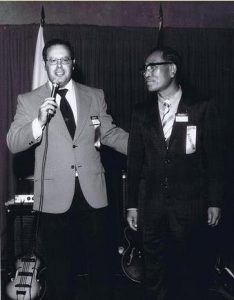
Mr. Cohen was born in 1939 in Minneapolis, MN to Leo and Rosabelle Cohen. This was the same year that his father started selling bicycles so, he was born into the industry. In 1946 the Cohen’s moved to Los Angeles, CA and opened up a shop called the Playrite Bike Store.
At the ripe old age of 7 Howie began to work in the used bike area of the shop. He would repaint the bikes, becoming very proficient at matching colors, rebuilding the wheels and hubs and installing new saddles and fenders.
STARTING THE WHOLESALE BUSINESS
Howie’s father would buy parts directly from the manufacturers, so other shops began looking to him for parts. This created the opportunity to start his own wholesale business and thus, West Coast Cycle was born.
Unfortunately, Leo Cohen passed away in 1963. Rosabelle then sent Howie to England to look into new bike sources. After visiting several factories, he came away very disappointed about their manufacturing capabilities. At the time, they were selling a boat load of bikes but were indifferent about quality issues. They would also stop working for tea breaks several times a day.
JAPAN MANUFACTURERS = QUALITY
Howie then turned to Japan. They were currently exporting cheap Japanese bikes to the U.S. that sold for $19.95 to $29.95. He visited various factories including Shimano. He would use the phrase, when visiting the factories, “We want to buy very high-quality bikes and we don’t care what they cost”. All the factories insisted that they could provide what he wanted but Howie was seeing otherwise.
Howie returned from Japan pretty discouraged. His mother, however, sent him back to Japan to keep looking. After visiting several factories, he came across Kawamura Cycles. This factory gave him confidence that they could produce the type of bikes he wanted. This visit lead to the first high-quality Japanese bicycle brand being exported to the U.S.
Howie then spent several months visiting and meeting with parts manufacturers such as Sugino, Takagi, Shimano, Asahi, Dia-Compe, Kashima, Taihei, Mitsuboshi and Mikashima (MKS).
He convinced them into producing the high-end parts that, before this time, they had not previously manufactured. Howie then proceeded to order over 500 bicycles from Kawamura and made the decision to sell them as “American Eagles”.
INCREASE DEMAND
He was apprehensive about the order but after just a few months, the dealers were clamoring for more. WCC were selling tens of thousands of these bicycles. About 1967 Howie was visiting a bike shop and over heard a customer say, “who are they trying to fool? It says American Eagle, but it’s made in Japan”.
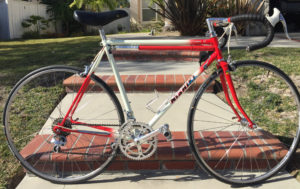
Knowing that Japan had built a good reputation for quality with other products, he decided to use that reputation with his bicycles. Even though the dealers did not agree, Howie decided to rename the bikes. He created a contest with the Kawamura employees offering a $1,000 for the three best names.
The winner was Nishiki, which referred to a wedding kimono mad of a fabric brocade with gold thread. They eventually phased out the American Eagle name and replaced it with Nishiki. Azuki, which was the runner-up name, became another brand that they imported.
DEMAND FOR BMX PARTS INCREASES
Due to the success of these two brands, Howie was able to retire at 37 years old. Since retirement wasn’t for him, he then became interested in antique and BMX bikes. When dealers started calling him for BMX parts, he decided to start Everything Bicycles, a BMX wholesale business.
He started building relationships again, purchasing grips from Jim Jannard who later founded Oakley. A dealer asked for color-anodized components, so he turned to Dia-Compe to make them. This dealer, Richard Long, was the founder of GT Bikes.
BMX LEADS THE WAY
Everything Bicycles became the BMX leader in the U.S. Since Howie had friends at Kuwahara in Japan, they asked him to help them with their brand. Howie put ads in a popular BMX magazine, Bicycle Motocross Action, offering free stickers to anyone who could pronounce Kuwahara correctly. It was a very successful promotion and led to two of Steven Spielberg’s nephews, who were part of a kids focus group for the movie E.T., to tell Steven that their favorite brand was Kuwahara.
Universal Studios called Mr. Cohen and asked him to build some Kuwahara bikes for the movie. His company also retained the rights to sell the bikes with the E.T. name. Initially They sold many of these bikes. But they but fazed out just as quickly. In order to get rid of the overstock he ended up selling the remaining bikes to Toys-R-Us.
BUSINESS BECOMES TOO BIG
When his business became too big and was no longer fun to operate, he collected what he could and then shut down the business. In the early 90’s he was contacted by a company in Taiwan, who was manufacturing Gary Fisher Bicycles. The company was losing money and they wanted Howie’s help. They asked Howie to spend a day at the factory in California. He ended up not returning home for over a year and a half.
He ended up brokering a deal between Trek and Fisher Bicycles which became beneficial for all concern.
THE CONSULTING PHASE
Howie stayed in the industry as a consultant until his untimely death at age 74 in 2013. Cohen had been treated for lymphoma since 2005. He was in remission up until June of 2013. This was reported by Gene Smith, retired president of Kool Stop. Gene was with Howie at the time of his passing and had been a friend for the last 50 years.
A quote from a family member: “He loved the bike industry. He was in it since he was 7 years old,” she said. “He just loved bicycles (especially Japanese bikes). It wasn’t a question of the business or the monetary rewards, even though that came. He just loves the industry and the people, and the challenge of seeing the progress and the innovation.”
BEN LAWEE: UNIVEGA
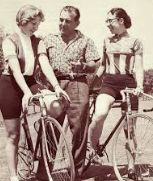
Our next man who was highly influential during the bicycle boom was Ben Lawee. Ben was born in 1926 and immigrated to the US as a teenager and was said to have arrived here by cargo ship. Knowing the importance of education, he attended the University of Columbia in New York.
WORKING HIS WAY THROUGH COLLEGE
Ben paid his way through college by working for another influential person, George Joannou founder of Joannou Cycles of New York. Not only was he important to the industry, but to Ben’s education into the bicycle world as well. George Joannou, a fellow immigrant, came from the Greek island of Cyprus and had the idea of importing lightweight European bikes to the United States. So, He started his business in 1937 and expanded to other facilities in New Jersey and Miami.

Ben became a sales representative for Joannou Cycles and was relocated to the west coast. This is where he decided to stay in the industry and run his own bicycle shop. He purchased the well- known, Jones Bicycle Shop in Long Beach California from the founder Frank Samuel Jones who opened the shop in 1910.
Ben purchased the shop in 1959 only a couple of years before Frank passed away. Ben grew the business and opened other locations. He eventually sold the business to Robert Olson in 1965 and moved on to importing other brands. The shop changed hands a couple of time and finally closed for good in April of 2018.
IMPORTING BEGINS
Ben was into providing a quality bicycle at a reasonable price. He started importing Bianchi’s, Legnano’s, Motobecane’s and Raleigh’s direct from their countries of manufacturing. He seemed to have a big influence on the Motobecanes since he was the US distributer.
It is said that he had a big hand in making Motobecane one of the best production bikes that came from France. Through his influence, he improved the building process and the paint schemes and recommended better component selections. He convinced Motobecane to use Japanese components (Suntour) for good quality at a reasonable cost. His insights and excellent choices in these areas led to the success of his own brands.
CREATING HIS OWN BRAND
Ben was a stickler and was upset by how expensive some bikes cost and still did not fulfill his customer’s needs. So, in the early 1970’s, he created his own brand, the Italvega. He selected the Torresini factory in Padua, Italy to manufacture the bike. This was the same factory that was building the Torpado bikes.
This was around the same time he convinced Motobecane to use Japanese components since they were performing better than the Italian components he was using on the Italvega. The Italian companies were becoming unreliable and constantly missing delivery deadline dates. This was hurting the Italvega dealers so, he decided to turn to another manufacturing source.
THE JAPANESE CONNECTION
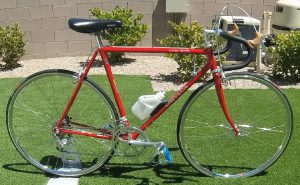
This resulted in the relationship with Miyata to build his new bicycle. Since his bikes were no longer manufactured in Italy, it was logical to change the name. The Japanese bikes would now be changed from Italvega (Italian star) to Univega (universal star).
Ben stopped distributing the Motobecane brand to concentrate on his new bicycle. He was able to spec the bikes the way he wanted and also made decisions about color choices. Since deliveries were now on time and the bikes were of a higher quality, sales took off.
Ben had an uncanny ability to select appealing color and decal combinations. He and his employees would test different color combinations on the frames and with the decals to see how they would go together. He wanted to make his bikes to look more expensive and modern than his competition.
THE ANSWER: ITALIAN SOUNDING MODELS
That idea was successful with the mid-priced bicycles but still did not translate to the higher end bikes. To try and compete with the Italian brands, he came out with some Italian sounding models. One of these was the Super Speciale that was fitted with Campagnolo Super Record components. Even though this was a great bike and could have competed with anything from Italy, it still didn’t have the reputation as a high-end racing machine.
The problem was that Ben did not believe in sponsoring pro teams or individuals. Even the Italians knew that you needed pro victories to create and sell a high-end bicycle brand. He then tried the Bertoni brand in 1980. There is much speculation on what manufacturer built the Bertoni brand but the school of thought is Daccordi.
THE DACCORDI CONNECTION
Ben actually used the specifications of a Daccordi with the paint, bottom bracket shell, seat lug and the pantography. This relationship with Daccordi does not necessarily prove that they built the Bertoni but that along with the similarity of how both bikes were built, highly suggests it.
Ben does not get enough credit for the impact he had on mountain biking, but he along with Mike Sinyard of Specialized, saw the appeal early-on. Univega introduced the Alpina Sport the same year Specialized came out with the Stumpjumper. The Alpina Sport was priced at $650 and the Stumpjumper at $850.
AN EYE FOR DESIGN
Ben was a no-nonsense person who ran a tight ship. A former employee states, “If you crave praise, you were in the wrong place”. Ben never rode a bike but still had a keen eye for colors and design and was very sharp when it came to reading the bicycle market. He actually collected cars but the bike industry made him a millionaire.
He sold Univega to Raleigh in 1996 and retired from the industry. It was said that “The bike industry was truly his life. It was his reason for getting up in the morning.
Lawee spent his entire career in the bike business, acting in every role in the industry from retailer and sales rep to distributor and supplier.
He enjoyed making products that were extremely attractive, had good performance and great value. His signature was a bicycle that looked and performed at a great price,” said his son, David Lawee, who worked at Univega for 15 years.
Ben Lawee passed away November 8, 2002 after losing a bout with stomach cancer. He was 76. Lawee had two children, David and Monique, with his wife Ariela.
SID AND ERNST STAR: LOTUS

In the 70’s Sidney Star owned and operated Alpha Cycle and Supply Corporation. He was selling a bicycle that he designed by the name of Windsor, which was being manufactured by Acer Mex in Mexico City, Mexico. In order to be competitive in the market of that time, he needed to be involved in the modifications of the bike.
In 1980 Ernst Star, Sid’s son, left a job at a University to joined him at the company to start a new brand by the name of Lotus. Ernst created the name and also had it registered around this time.
Acer Mex decided to reorganize which created a dip in quality. This required more of the Star’s time to make sure that the high standards they were expecting were being met.
LOTUS INTERNATIONAL CORP BORN
A year or two later the two formed Lotus International Corporation since they decided to drop the Windsor brand and concentrate on the Lotus brand exclusively. They had also moved production to Tsunoda of Japan, which had been in business since 1926, and knew how to build a quality bicycle.
 With the attention now on Lotus, they were able to turn out some very high-quality bicycles and a variety of models. From the Cobra BMX series bicycles to the 2000R 3000R and 4000R mountain bikes.
With the attention now on Lotus, they were able to turn out some very high-quality bicycles and a variety of models. From the Cobra BMX series bicycles to the 2000R 3000R and 4000R mountain bikes.
THE ITALIAN CONNECTION
Lotus formed an alliance with Cinelli and had a few high-end models made in Italy under their supervision. They used Columbus SL tubing, Cinelli parts and Campagnolo components. These “Cinelli Designed” models were most likely manufactured at the Chirico factory in Bussero, Italy. The same factory where the now very collectable, Centurion Cinelli Equipe was manufactured.
Their touring bikes were second to none starting with the 1983 Odyssey. This was not the first year for this model but was the year that they totally redesigned the bike. This years Odyssey saw the switch from Tange 1 tubing to the Italian Columbus tubing for the frame and fork. It now came with additional brazed-on fittings including eyelets for fenders, touring racks and fittings for two water bottles.
FINANCING CONCERNS
On the business end things started to change. According to Ernst Star, “Our company depended heavily on outside financing to fund its growth, and when the bank we had been using unexpectedly changed hands, that financing was interrupted while the new owners familiarized themselves with their accounts and put in mechanisms to address our specific needs”.
This situation created a financial hardship for Lotus and almost led to bankruptcy. They eventually sued the bank for breach of contract so that they might recover damages. They were not at liberty to discuss the suit and the settlement so we cannot report what the results were.
Since the demand for Lotus bikes was still very high, they were now obligated to deal with unfamiliar third-party distributors that had the financing to take care of and service their accounts. Ernst recalls that one of these distributors had the gall to call himself, “Lotus Distributor”.
THE TORCH IS PASSED
Sidney Star’s health was declining and he eventually passed away in 1990. Ernst decided to dissolve Lotus International and form another company called International Licensing & Design Corporation or ILD. ILD kept the Lotus brand but licensed out the bikes to be sold by others. He kept busy by working as a design and marketing consultant for the brand.
Ernst sold licenses to China company, Group Lotus in the UK and to Sears and Walmart in the US. In 2000, Ernst sold the Lotus mark to Group Lotus and return to teach at Hofstra University in New York.
There was an old wives tale about a container of Lotus bicycles sinking at sea which forced them out of business. Of course, this was not true. What really happened was that a ship was delayed because of a severe storm and one of the containers was damaged.
MITCHELL WEINER: CENTURION
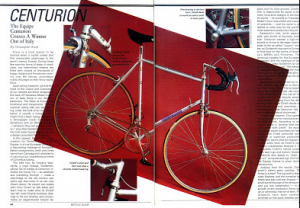
Mitchell Weiner was born in 1932 in Romanian and immigrated to the U.S. at the age of 16. Prior to 1971, Mitchell was an importer of various products. It seems he imported items that were very sellable and somewhat in demand such as, door stops and plastic ring binders.
It’s not quite clear how Raleigh’s American Division found him but they wanted the new “Grand Prix” model to be manufactured in Japan and needed someone to source and import them. Welcoming this new opportunity, Mitchell found the H. Tano factory, who had a good reputation, to manufacturer and deliver the new model.
RALEIGH CANCELS DEAL
He optimistically ordered 2,000 bicycles with the specified Raleigh color combination and head badge. After receiving the order, he was informed that the parent Raleigh company in Nottingham, UK, nixed the deal and found himself with a few bikes on his hands.
The only thing left for him to do was to try and unload and sell these bikes. The timing happened to be fortuitus for Mitchell and his company, Western States Imports, since the bike boom was underway.
He renamed the bikes after a book he was reading (The New Centurions), had some decals made and a new head badge that was designed so he could use the same screw holes, and he was off and running.
Bikes were selling like hot cakes and his new brand was no exception. He sold all the bikes within a few months and needed to order more. After a few years Mitchell dropped the other products he was importing and concentrated only on selling his new Centurions.
A NEW PARTNER
A Los Angeles bike shop owner, Michael Bobrick, was aware of how well these new bikes were selling and how few would come back for tune ups and or adjustments. The typical mid-tier bikes from England and Europe were needing adjustments not long after they left the shop new.
He wasn’t sure why the Centurions were not coming back to the shop for adjustments until he spoke with one of his customers who said that he didn’t need to bring the bike back for anything since everything was working great.
Impressed with the quality of this new brand and dealing with Mitchell, Mr. Bobrick sold his shop in 1972, invested in and joined Mitchell at WSI.
J. YAMAKOSHI AN INSTRUMENTAL PARTNER
An instrumental player at Centurion was Junya Yamakoshi or otherwise known as “Cozy”. Junya was the Centurions product development manager. He was responsible for coordinating manufacturing with the Japanese companies, importing the bikes and designing the frames. He worked with Bobrick and along with the company’s Diamondback team manager, Sandy Finkelman. Junya left the company in 1986 to start his own company, Parkpre Mountain Bike. He eventually got the company started and was building bikes in the early 90’s until 1998.

Centurion continued to import some great models of which some are highly collectable today. One of the top models produced was the Centurion Cinelli Equipe. This model was made in Italy under the supervision of Cinelli. Only made for one year, 1985, it is probably the most collectable of all Centurions. Other great models were the Turbo, the Professional, the Comp TA and the Ironman Master and Expert models.
HANDS-OFF CEO
Mitchell Weiner described himself as a hands-off CEO. He was never a bicycle nut and normally only road on the weekends. Mitchell was very much into computers and would rather discuss databases with someone rather than bicycles. He at one time built his own computer from a kit and he was involved with improving the company’s inventory software.
The company grew fast. Sales in 1985 were 37 million, which was up 68% over the past 3 years. They were slated to make 50 million in 1986 and expected to bring in 65 million in 1987.
In the mid 80’s the Yen was gaining steam and it became unprofitable to continue with Japan for manufacturing. In 1986 the Signet model was brought to the U.S. which was the first Taiwanese manufactured bike.
CHANGE OF DIRECTION
Soon, they moved the entire production to Taiwan and around 1990 Western States Imports put the Centurion brand under the Diamondback moniker. Even though the bikes had decals stating “Centurion Design”, “Exclusively built for WSI” and Designed in the USA, the new moniker did not go over well and sales started to dry up. Mitchell retired from the business in 1991 but it appears that Michael Bobrick continued with the company for the next 9 years.
A German importer by the name of Wolfgang Renner had been importing Centurions since 1976 and also made a mountain bike brand that was called the “Country”. Wolfgang bought the rights to the Centurion brand in 1991 and as far as we know, it is still a German brand today. Renner has kept the engineering and design within his company.
TIMELINE NOT CLEAR
It is not quite clear of the timeline but a company by the name of Derby Cycle Corp. was building bikes for Diamondback as well as Raleigh Cycle Co. of America. This led to them purchasing Diamondback from WSI in 1999. WSI finally closed down in 2000, ending a long and prosperous run.
It’s interesting to note, that in September of 1998 WSI filed a lawsuit with the U.S. court of appeals involving the classifications of one of its cross or hybrid bicycles. The Court of International Trade was classifying the bike as a “mountain bike” which pays an 11% duty to be imported. Road bikes paid a 5.5% duty.
Western States Import Co., Inc., Plaintiff-appellant, v. the United States, Defendant-appellee, 154 F.3d 1380 Fed. Cir. 1998
The argument was that since the bikes in question were able to use a tire with a cross-sectional diameter exceeding 4.13 cm, they were then assigned the classification as a mountain bike. WSI contends that the bikes were shipped with tires not exceeding that limit, so they should have been classified as a road bike. In the end WSI lost the appeal and had to pay the higher duty.
THE END OF AN ERA
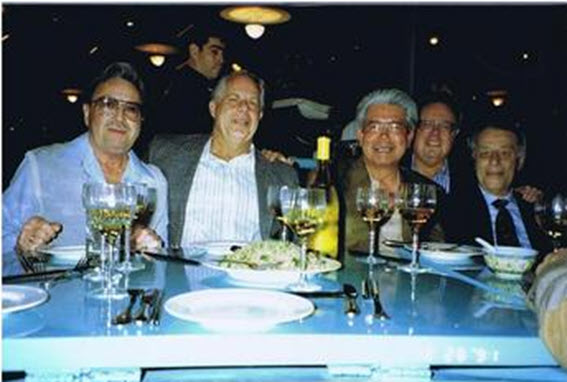
This era came to an end due to a few situations which created the down turn of these brands. Even though they were creating the finest Japanese bikes with top-notch frames and components, they were never able to create the same reputation as bikes coming out of Italy.
Most, if not all of these men, realized this and tried to create new models with Italian sounding names using Italian tubes sets and Italian components. A couple of brands went as far as teaming up with Italian manufacturers and had frames built in Italy under their supervision.
Another concern was, only a few of these brands sponsored pro teams which was needed to validate the product as a high-end racing machine and produce a higher profit. The demographic was changing and less people were buying bikes just to ride around and more wanted high-end bicycles to race or for club rides.
The third and most decisive situation was the exchange rate change between the Yen and dollar. The brands created by the men mentioned in this article were started around the early 70’s when the exchange rate was 358.000 Yen to 1 dollar.
YEN TO DOLLAR RATE CONSTANTLY CHANGING
In the September of 1978 the rate did change to 189.000 to 1 dollar, but it was still somewhat profitable at that rate. It did become favorable again in February, 1985 at 260.700 to 1. But from there on the dollar continued to fall to the Yen 121.100 to 1 in November of 1988, which put an end for these brands to be profitable. From 1990 until September of 2020 the Yen hovered from 145.000 to 105.591. So, the rates never became profitable again.
A few turned to Taiwan for manufacturing in the late 80’s but by then it was too late and these brands started selling to other big importers who were starting to use China which created the brands to be sold at the Walmart’s of the world.
 |
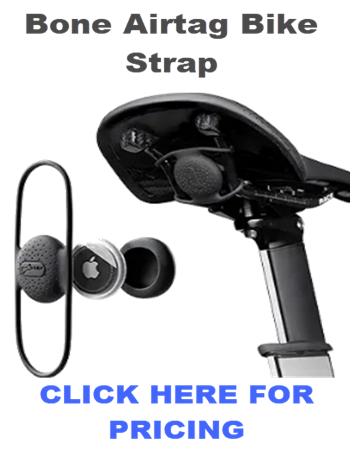 |
We earn from qualified Amazon purchases with NO cost to you. ANY item that you need or were going to purchased anyway through any of our links, helps support this site. Thank you for your support!

